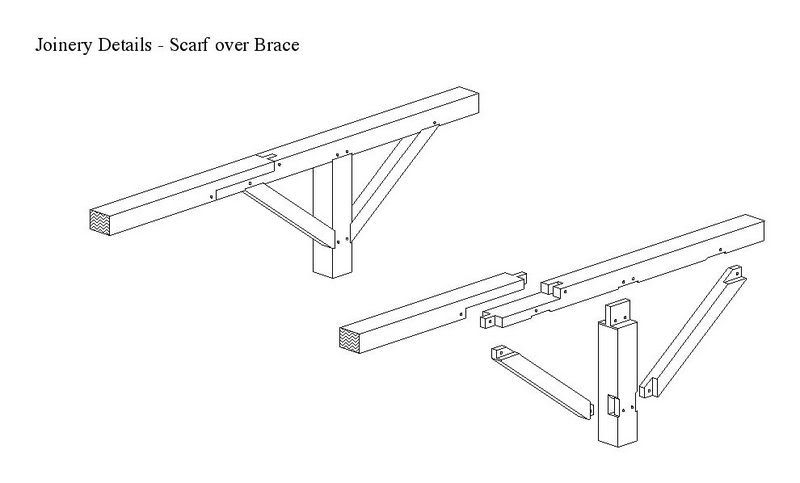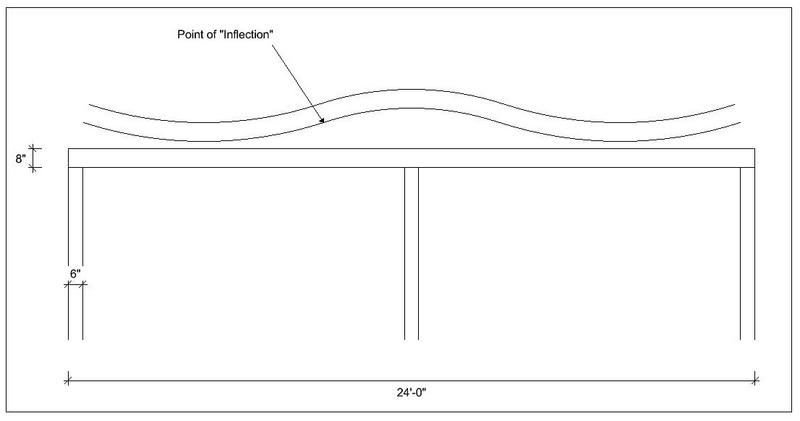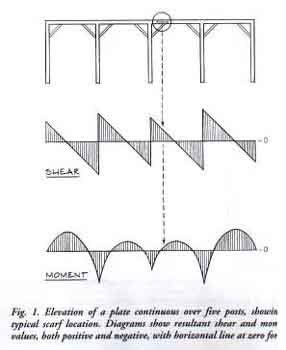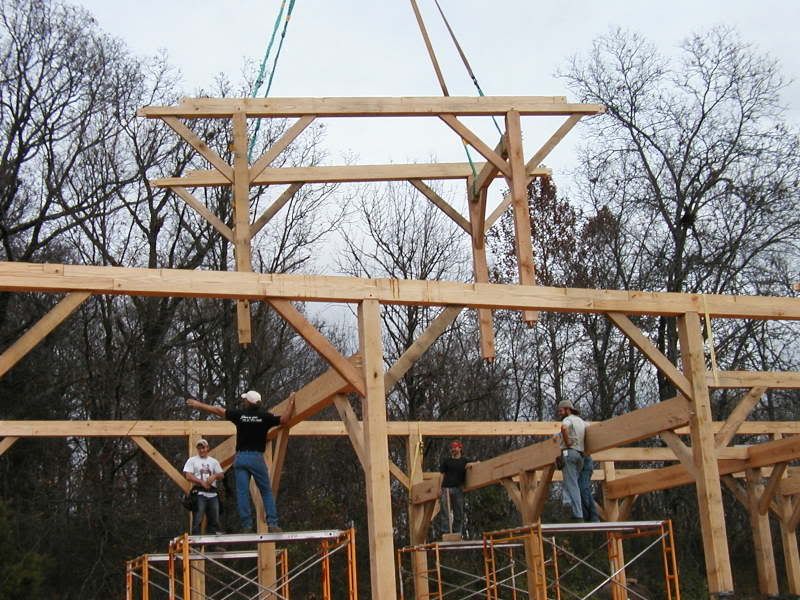Timber Framers Guild
scarfing question
Posted By: Brock Smith
scarfing question - 01/05/07 04:50 AM
Hello all,
is scarfing over a post acceptable? It seems to me that a scarf is most common over a brace - what is the reason for this location? My guess has often been that when the braces are loaded in C&T, the tendency would be to try and 'dislocate' the scarf if it were over the post???? If this is the case, then the lower blade should catch both braces and the post tenon?
Thanks folks,
Brock
Posted By: E.H.Carpentry
Re: scarfing question - 01/05/07 11:48 AM
Good morning Brock,
I my opinion you should be able to put the scarf joint close to a post because of leverage.( one beam has to hold the other) It does not matter if it is right on top of the post or a within 2-3 feet of it. I think that right on the post might even be better because that would put less weight on either beam since they will not have to hold each other and instead rest on the post.
If it were the case that the c&t of the braces would dislocate the joint if one were to put it right on the post then same would be true if it is not. You still need to attach the beam(whether it has a joint or not)to the post via t&m. So now if the braces are putting a load on the beam it cannot dislocate.
Just my two cents.
Best Regards Enrico
Posted By: Dan Miller
Re: scarfing question - 01/05/07 12:27 PM
The scarf joint is best located where stresses (bending and shear) are lowest, and this usually falls over the brace, not over the post. This is illustrated graphically in Jack Sobon's "Timber Frame Construction" (the red book).
Posted By: Joe Bartok
Re: scarfing question - 01/05/07 02:24 PM
Jim Rogers posted an excellent description of scarf joints somewhere else on the Internet but I can't find the link. As I recall it was recommended that the joint be at the beam's point of inflection. (Makes sense to me, having tutored newbies in basic calculus). Hopefully he will chime in and explain in more detail.
Posted By: daiku
Re: scarfing question - 01/05/07 02:48 PM
I agree with the other posters, Brock. A scarf joint weakens the timber in bending strength. The greatest bending forces usually occur right over the post (bending up), and also mid-span (bending down). That's why the scarf is usually placed somewhere in between. The stress over the post is higher than the mid-span stress, as it results from a point load (the post) rather than a distributed load (like a floor). Dan is talking about a diagram on pg 96 of Sobon's book, which sums this up better than I can with words. CB.
Posted By: Tom Cundiff
Re: scarfing question - 01/05/07 05:38 PM
post by Brock Smith
If this is the case, then the lower blade should catch both braces and the post tenon?
Yes. I think this is what you're talking about.

I do not like the brace triangle to be interupted by a scarf joint. But, I have also seen a lot of scarfs in old barns located over the posts. They held up just fine, so I'm not convinced that it's that critical. A scarf over a post with a through tenon to locate both halves, would not separate when the braces went into compression. Tom
Posted By: E.H.Carpentry
Re: scarfing question - 01/05/07 10:32 PM
Let's assume that there is a downward force applied to the beam on the left in the illustration. That would cause the other beam to bend down also and would put compression on the brace. Now the brace might be, and in all likelihood is able to support that load even though its real design purpose is to stiffen the frame. So the question is why wouldn't you want to put the scarf joint above the post. That way both beams end up in the same position and the braces can also add additional support to both beams equally well. In addition to that you would be able to put a through tenon on the post which can secure the scarf as well as held the beams in place/down(pegs).
The right beam in the drawing would be the stronger one since the one on the left is scarfed onto it and only supported by the blade and the brace but not the post.
Try to imagine the same drawing without the braces. Now where would you put the scarf joint?
Not sure if I am bringing my point across!?
Posted By: Tom Cundiff
Re: scarfing question - 01/06/07 02:57 AM
or over the post

I have done it both ways
Posted By: E.H.Carpentry
Re: scarfing question - 01/06/07 04:01 AM
@ Tom,
aside from the reasoning for having it over the post or the brace. I just like the over the post version simply because it looks more balanced/ symmetrical.
But time has proven that both versions will work.
Posted By: Brock Smith
Re: scarfing question - 01/06/07 05:00 AM
Thanks guys, I really appreciate the info. I checked page 96, and Sobon's description helps out.
Now if I may, I'd like to ask further. What about scarfing a structural ridge? King post truss, pitch is 30 degrees, span is 22ft, common rafters are to rest on top of the ridge. I think I can get away with interupting the plates at the posts and omit the scarf at that location.
Geez. I really have to get on the computer drafting bandwagon. Does anyone here still user a big ole' klunker drafting board?
Thanks again,
Brock
What's the length of your ridge?
Is scarfing really necessary?
From what I understand, continuous grain is a good thing.
If you can get a long enough timber....
Posted By: Brock Smith
Re: scarfing question - 01/06/07 05:48 AM
Hey TG, total length would be around 34'. I have been so fortunate as to work with a number of those beasts, usually 8x12 D fir, but this project is on my own, with the only help coming from my trusty spaniel named Wallace. I'd love to use a full one, but the material handling is my biggest concern...
Cheers,
Brock
You - dog - 34' ridge -
How big is your dog? :p
Yes, I see...
So, I'll butt out now and continue lurking instead.
Peace
Posted By: E.H.Carpentry
Re: scarfing question - 01/06/07 12:07 PM
@ Brock,
trying to get anything longer than 20' seems to be pretty tough these days. You could consult with a logger.
But if you are going to scarf it anyway so that you can handle it yourself you should be able to put the scarf right on the king post.
Even a 20 footer is still pretty heavy to be dragging it around without help.
Posted By: Dan Miller
Re: scarfing question - 01/06/07 01:14 PM
The problem with Tom's second drawing (scarf over post) is that you've reduced the thickness of the beam by one-half at the point of greatest shear stress. As I understand braces, they are designed to prevent racking, not to carry load (though they may contribute to load bearing somewhat). The location of the scarf over the brace isn't so that it is supported by the brace, but rather it is located so that the combination of shear stress and bending stress are as neutral as you can get. It just so happens that it falls about a brace-length's distance off the post...
Posted By: Jim Rogers
Re: scarfing question - 01/06/07 01:17 PM
Here is the drawing that Joe was referring to:

Between the posts the unsupported timber will sag or deflect. Over the center post the timber will crown.
This causes this "exaggerated" wave shape effect in the timber.
At the point where the sag or deflection changes to a crown is called the point of "inflection".
This point is where the timber is neither sagging nor crowning. It has the least amount of both forces.
This, I am told, is where the joint should be made. If I understand all this correctly.
Here is the graph to prove this:

I personally don't recommend putting a scarf over a post because of this graph, but each situation is different, and they all have to be figured out, and built based on this.
Jim Rogers
Originally posted by Brock Smith:
Geez. I really have to get on the computer drafting bandwagon. Does anyone here still user a big ole' klunker drafting board?
Yup, a 60" table with a Vemco drafting machine, but generally it only gets used for final drawings. Graph & Hex paper for preliminary design work (and my own projects).
I would like to get proficient with a modern 3D CAD program. They sure come in handy when discussing things online or generating perspective drawings.
Posted By: E.H.Carpentry
Re: scarfing question - 01/06/07 05:17 PM
@ Jim,
I just purchased a bunch of literature to see which books you guys are actually talking about. One of them was the Sobon book of historic american timber framing which is where I also saw this drawing. ( Another reason was to compare Benson and Sobon since this comes up fairly often and I had no idea what any of this meant. Having looked at both I would definitly fall into the Benson category).
Back to the topic. Your/ Sobons explanation makes sense, at least parts of it. If you applied a load to the beam in the drawing it would indeed sag where it is not supported. But it does not actually go anywhere (neither up or down) above the post. It would crown up once you add the braces, in theory. But since everything is pegged together it won't. So if you have a full lenght beam going across the three posts shown and it sags midway between the posts it would put tension on the beam fibers above the post because it needs to "stretch/ become longer" to make up for the sag. Same would happen when the joint is put above the brace. Because the brace does not actually give. So it really supports the joint and holds it up as the post would. So in my opinion it should not really matter where you put the scarf joint. If in doubt I would add another post.
But Sobons drawing aside. Does anyone know of a lab test where this situation has been tested. There are test for pegged tenons and braces but I did not come across a test for the scarf joint.
Posted By: Tom Cundiff
Re: scarfing question - 01/06/07 05:31 PM
Originally posted by Dan Miller.
As I understand braces, they are designed to prevent racking, not to carry load (though they may contribute to load bearing somewhat).
If a brace is loaded in compression it can and will lift a plate off of the post if it is not pegged down. I believe that the braces do help carry the load and that the shear and moment charts do not take this in to account. The scarf, placed over the post with braces both sides, is supported in three places not just one. If the scarf is placed over the brace and the brace is helping to carry the load, where are the shear forces now ?
I believe in supporting scarf joints.
Doubting Thomas
Posted By: E.H.Carpentry
Re: scarfing question - 01/07/07 02:18 AM
@ Tom,
I totally agree.
Posted By: Brock Smith
Re: scarfing question - 01/09/07 05:31 AM
Thanks everyone! I appreciate your help.
Cheers,
Brock
Posted By: jim haslip
Re: scarfing question - 01/12/07 04:13 AM
*jumping in a little late, but what the heck*
I have always considered that the capacity of the Brace to care a load should not be considered when calculating spans, loads, etc, since the purpose of the braces is not to carry loads, but rather, to prevent the racking of the frame and stabilizng it against lateral loads.
On topic, I would splice the plate over the brace as directed in the above diagram if I have the choice, or over the post, as a second choice, if neccesary.
In the old text books also written by very experienced people, they advocate a balluster to help support a scarf joint if in fact one has to be used, you often see this in mill framing.
NH
Posted By: Tom Cundiff
Re: scarfing question - 01/13/07 02:23 AM
By Jim Haslip
I have always considered that the capacity of the Brace to care a load should not be considered when calculating spans, loads, etc, since the purpose of the braces is not to carry loads, but rather, to prevent the racking of the frame and stabilizng it against lateral loads.
I agree, but I do not think that we should continue to ignore the shear forces that the braces are capabale of exerting when they are loaded in compression. For this reason, I do not believe that placing the scarf joint over the brace is any better than placing it over the post. Tom.
Posted By: Brock Smith
Re: scarfing question - 01/15/07 04:01 AM
Hey NH,
Can you please explain baluster? I only know it in stair terminology.
Thanks,
Brock
Posted By: Tom Cundiff
Re: scarfing question - 01/15/07 05:04 PM
NH , do you mean Bolster instead of Baluster ?
Tom
Posted By: DKR
Re: scarfing question - 01/15/07 07:31 PM
Tom, in the drawing of the "scarf joint over the post" that you posted on 1/5, you have two pegs in the the post tenon, both into the lower timber. Why not have two pegs, with one into the lower timber and one into the upper?
Posted By: Tom Cundiff
Re: scarfing question - 01/15/07 08:05 PM
DKR, Good eye for detail.
If the plate material is green it will shrink. Being pegged to the tenon in both places may seperate the two halves of the scarf as the plate drys.
Drawboring the pegs will keep the lower half tight to the post but may not be enough for the top half. The pegs in the scarf and the through tenon should be enough to keep it together.
I have also seen in old frames the through tenon cut just shy of flush with the top of the plate. Presumably so that it would not stick up as the plate shrinks. Tom
Posted By: Tom Cundiff
Re: scarfing question - 01/15/07 08:41 PM
I have also seen wedges dropped in from the top on the end of the mortice to tighten up the fit of the through tenon. Tom
Posted By: mo
Re: scarfing question - 01/16/07 05:05 AM
Just curious, but what about just using a stronger scarf joint that alleviates where you have to put it?
My vote is for the scarf joint to be directly over the post, and let the braces do the only job they are supposed to do keep the framework rigid
I have never seen a scarf joint over a brace in a traditional sense, It would be nice to hear if any other researchers or those that dabble in the historical field has seen a scarf joint over a brace.
I have been wrong before but lets hear some feedback
NH
Posted By: MTF
Re: scarfing question - 01/27/07 11:31 AM
I converted to scarf over brace about 5 or 6 years ago and have been very happy with the results. I’m not a 'true student' of historical frames, but the location of scarfs is a feature I look for. I agree it is not the norm to find the scarf located over the brace, but I have seen them there. I’ve also seen examples of the scarf over the post with the scarf showing signs of separating due to high bending loads.
Thanks,
pete
Posted By: Timbo
Re: scarfing question - 02/04/07 10:01 PM
I never understood the scarf over brace idea, but now it makes more sense. I would still scarf (or more likely lap joint)over the post because it looks stronger , more symetrical , and doesn't rely on the brace for support. yes, i believe ,no I know braces often share loads . Braces ,especially in old barns can rot at the lower part of the brace and fail.
Posted By: Tom Cundiff
Re: scarfing question - 02/05/07 02:33 AM
There are some advantages to locating the scarf over the brace. The picture shows purlin plates and posts assembled and lifted into place, keeping workers close to the ground. The fewer connections in the air the better. Tom

Posted By: E.H.Carpentry
Re: scarfing question - 02/05/07 11:45 AM
Tom,
is the goal building a frame that can be completely assembled on the ground or should it be build correctly engineering wise?
I still would put it over the post.
And what happens when the rafters and Sips get installed? Somebody will have to be up on the roof.
There is nothing better then scaffolding when it comes to raisings and plenty of it.
Posted By: daiku
Re: scarfing question - 02/05/07 01:41 PM
Another vote for scaffolding. And fill in that stiarway hole while you're at it. CB.
Posted By: Tom Cundiff
Re: scarfing question - 02/05/07 01:54 PM
EH, This is a frame that is 84' long. If the scarfs were located over the posts, there would have been at least half a dozen more of them to cut. This frame was built at a Guild workshop/rendezvou at the Botancial Garden of the Ozarks by 12 students in two weeks! I did not design the frame, I was just an instructor. I believe that material length plays a big part in determining scarf location. Raising sequence is also a consideration. Unless Testing is done to conclusively disprove the printed material on the placement of scarfs, we will probably see a lot more scarfs over braces, and I will continue to stir the debate. Doubting Thomas

Posted By: Colton Allen
Re: scarfing question - 03/08/07 04:16 AM
This may be a silly question, but say there is no brace. Should the scarf be over the post then?
Posted By: Michal Zajic
Re: scarfing question - 03/08/07 08:50 AM
Colton,
Surely it is a good idea but scarf does not have to be over post neither directly supported by brace in general.
I'd suggest you to have structural engineer locate the exact position and type of scarf. If you're not using structural engineer make it over post.
Michal
TFDesign.cz
Since the infamous diagrams of shear and moment ignore the knee braces the same logic would apply.





